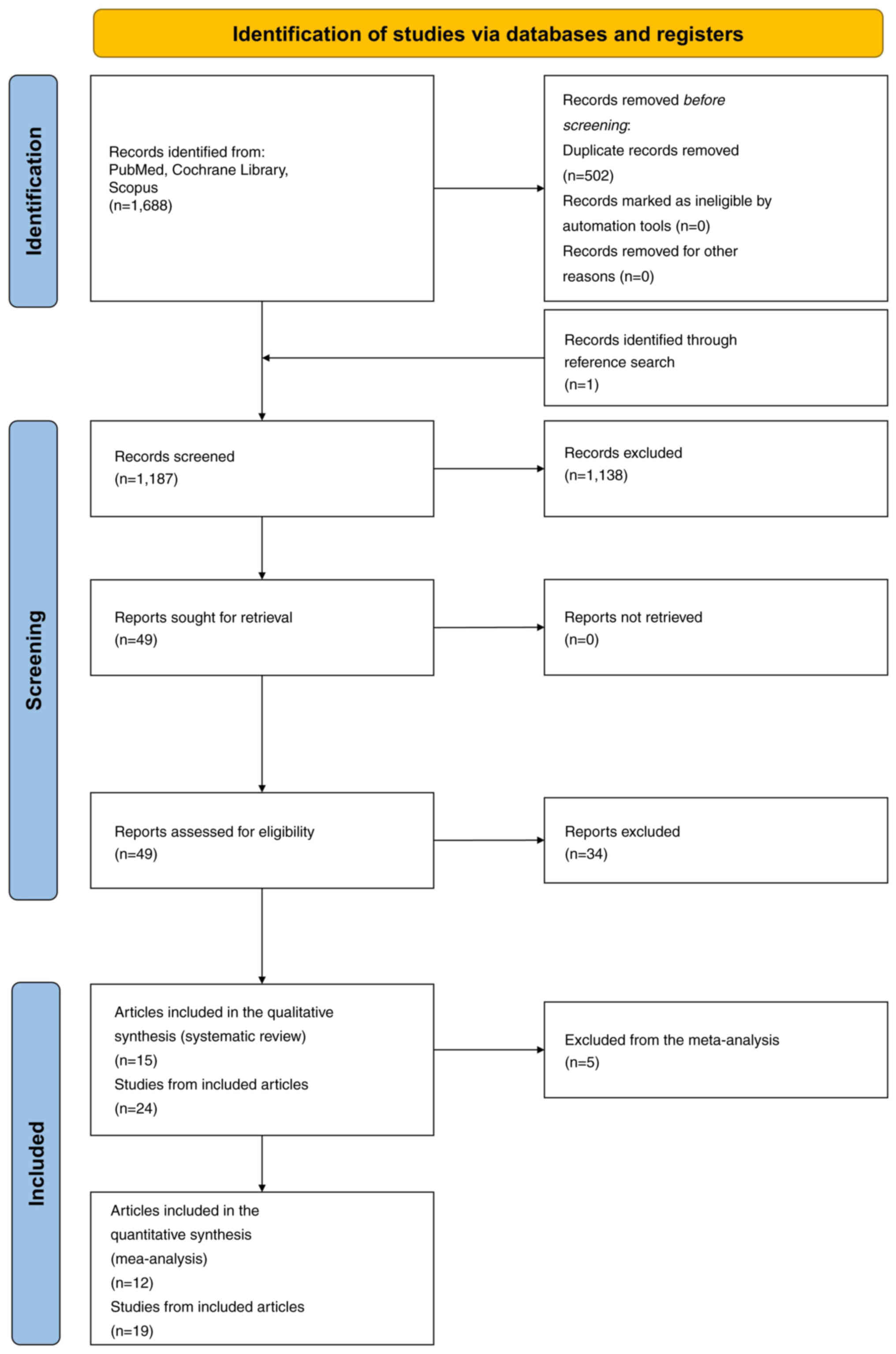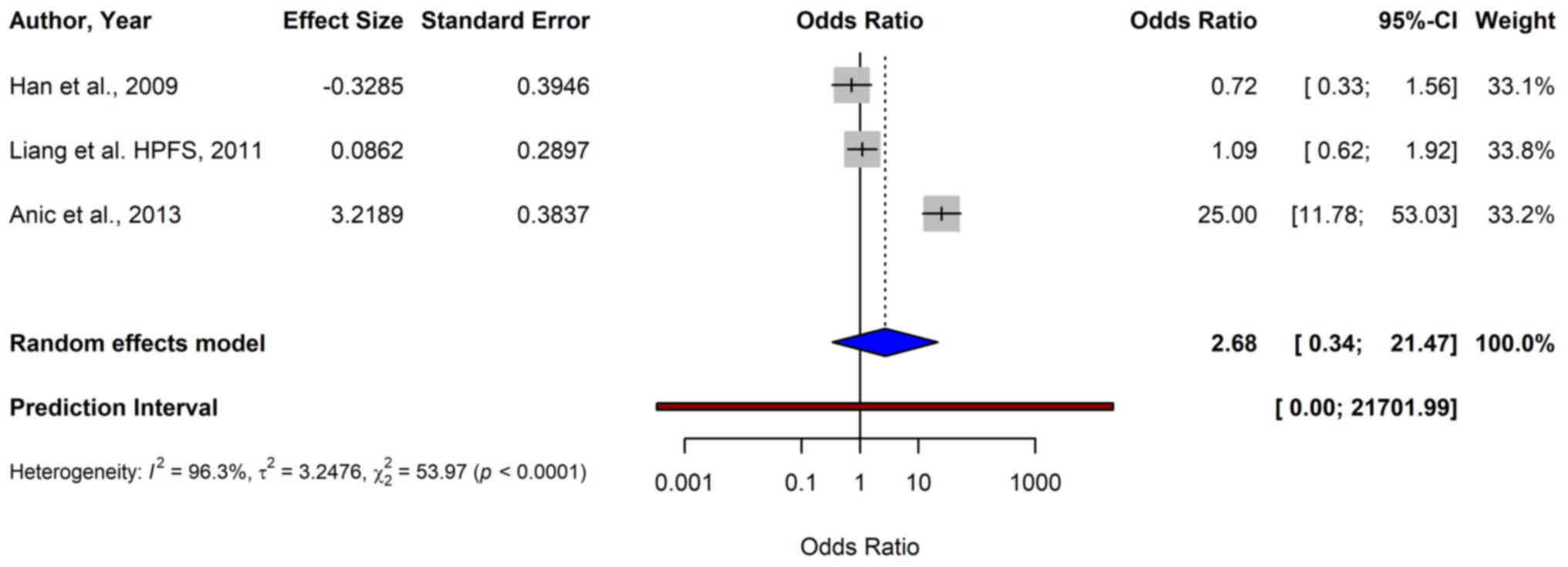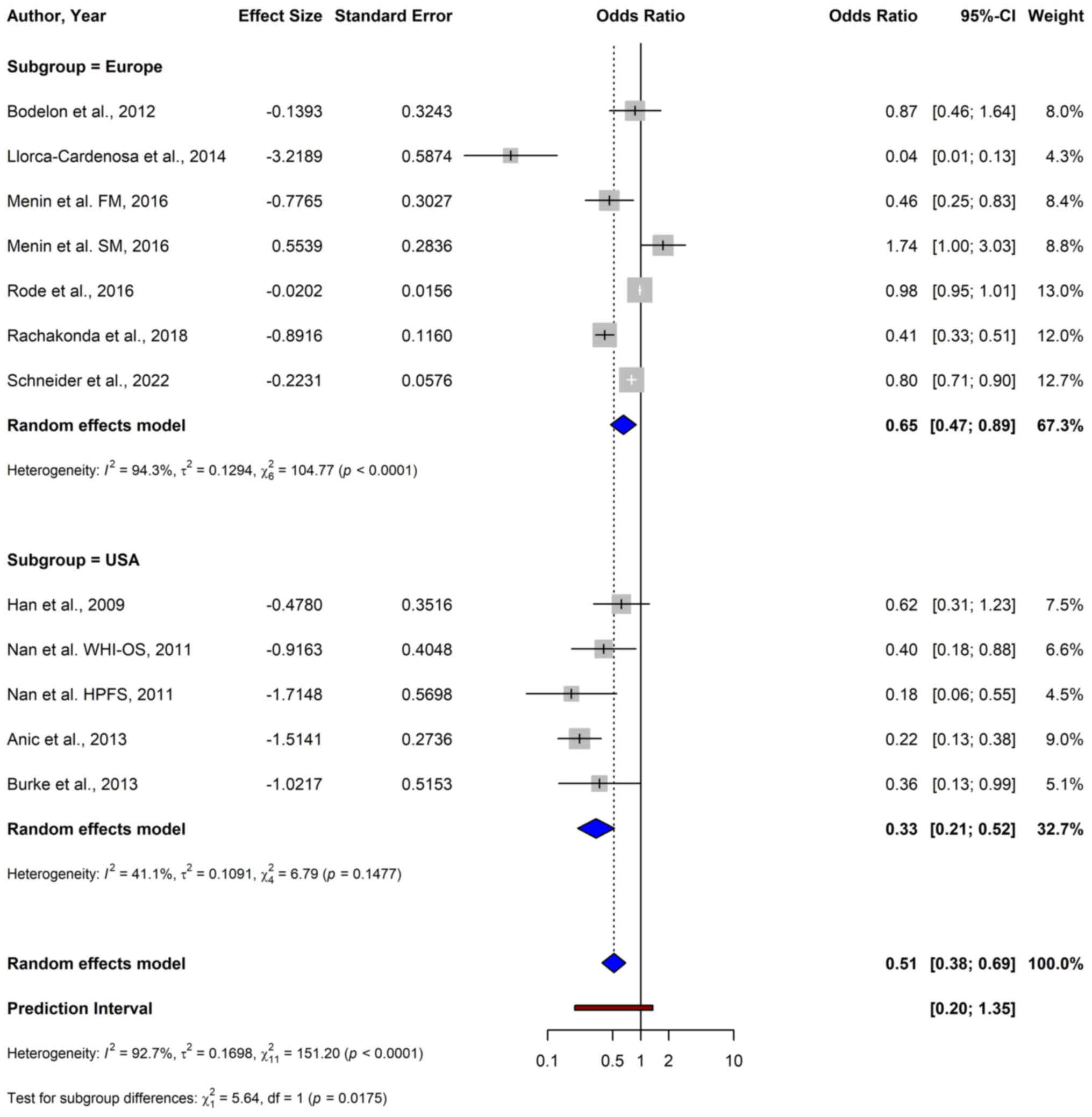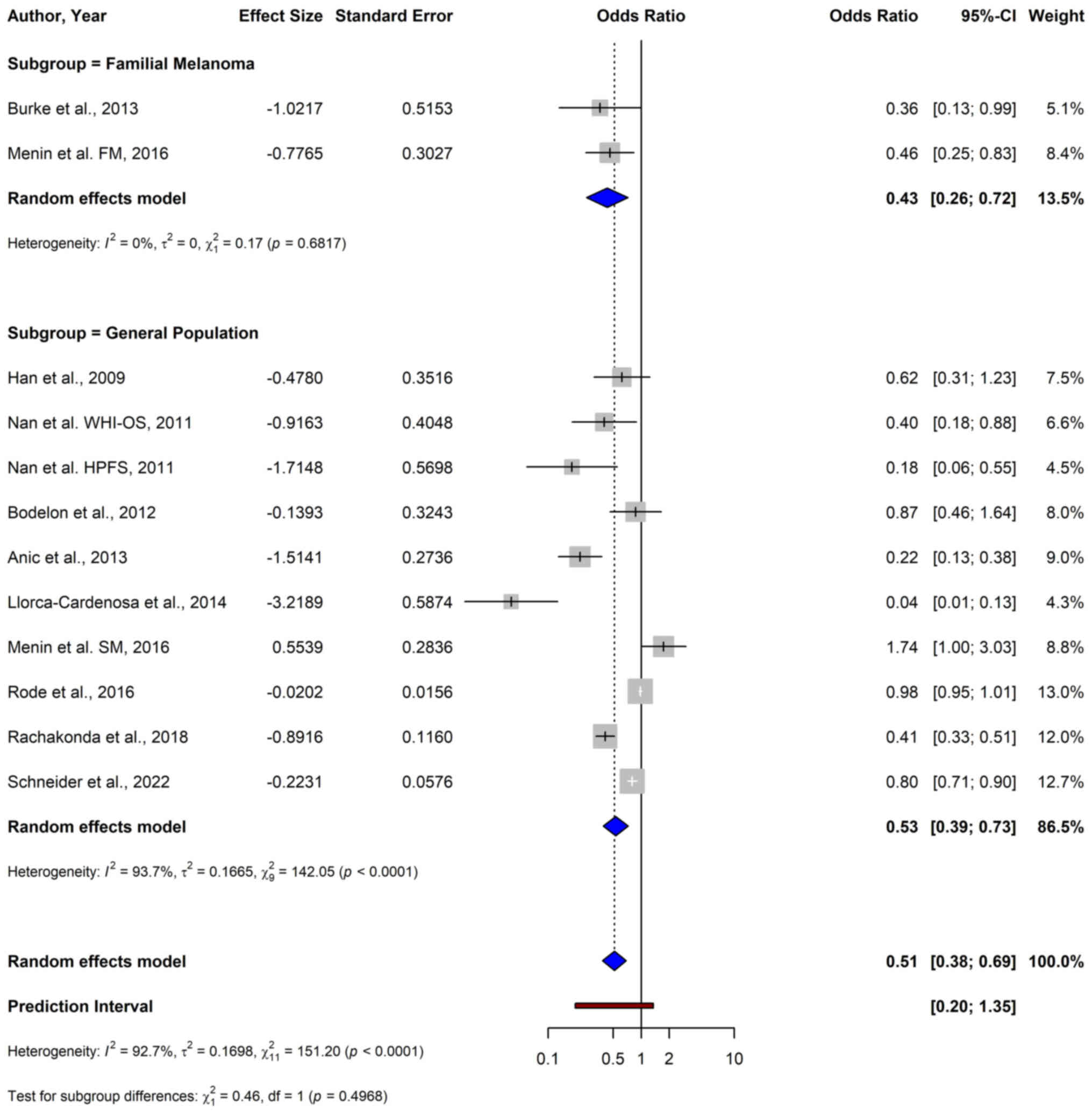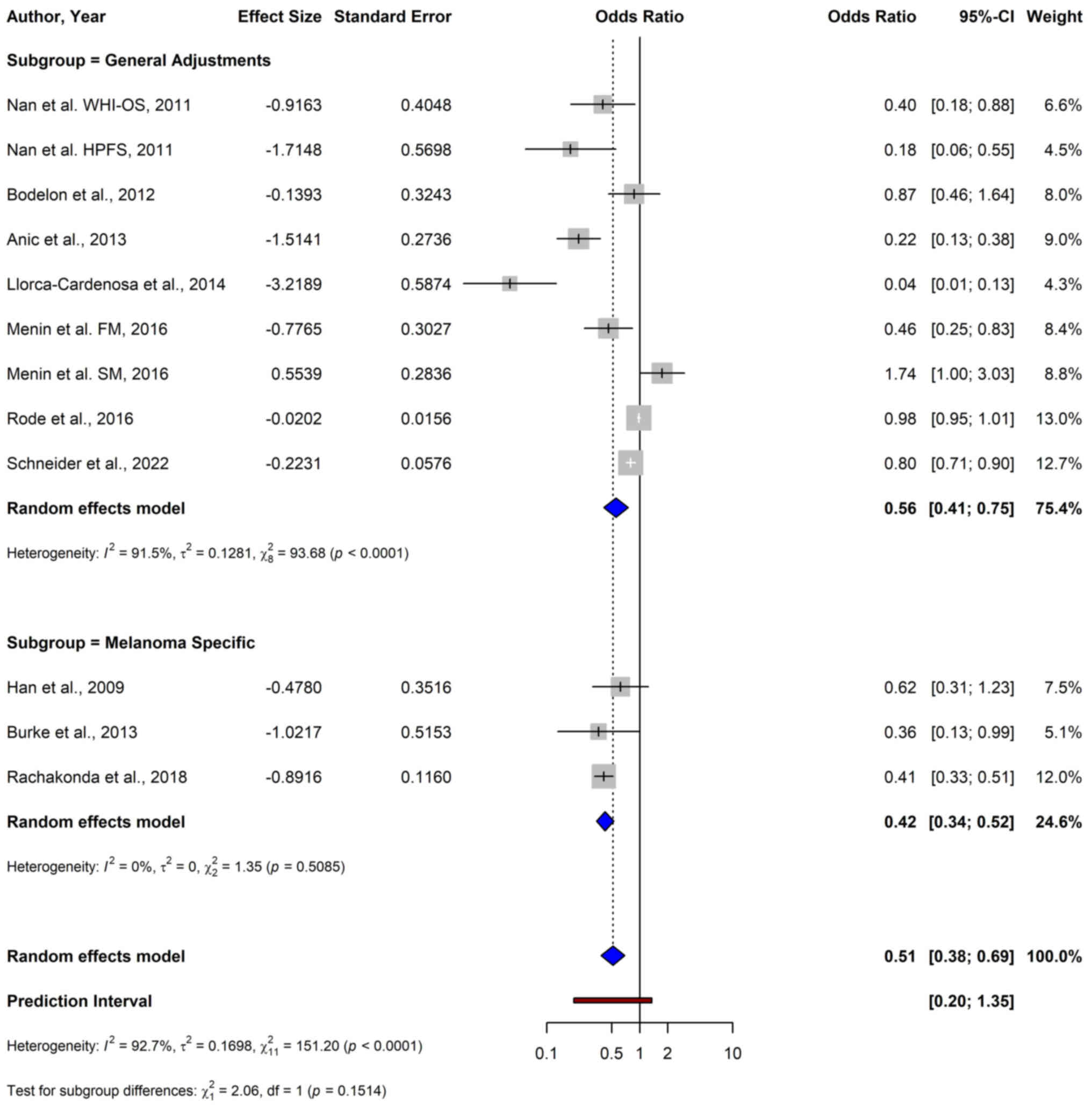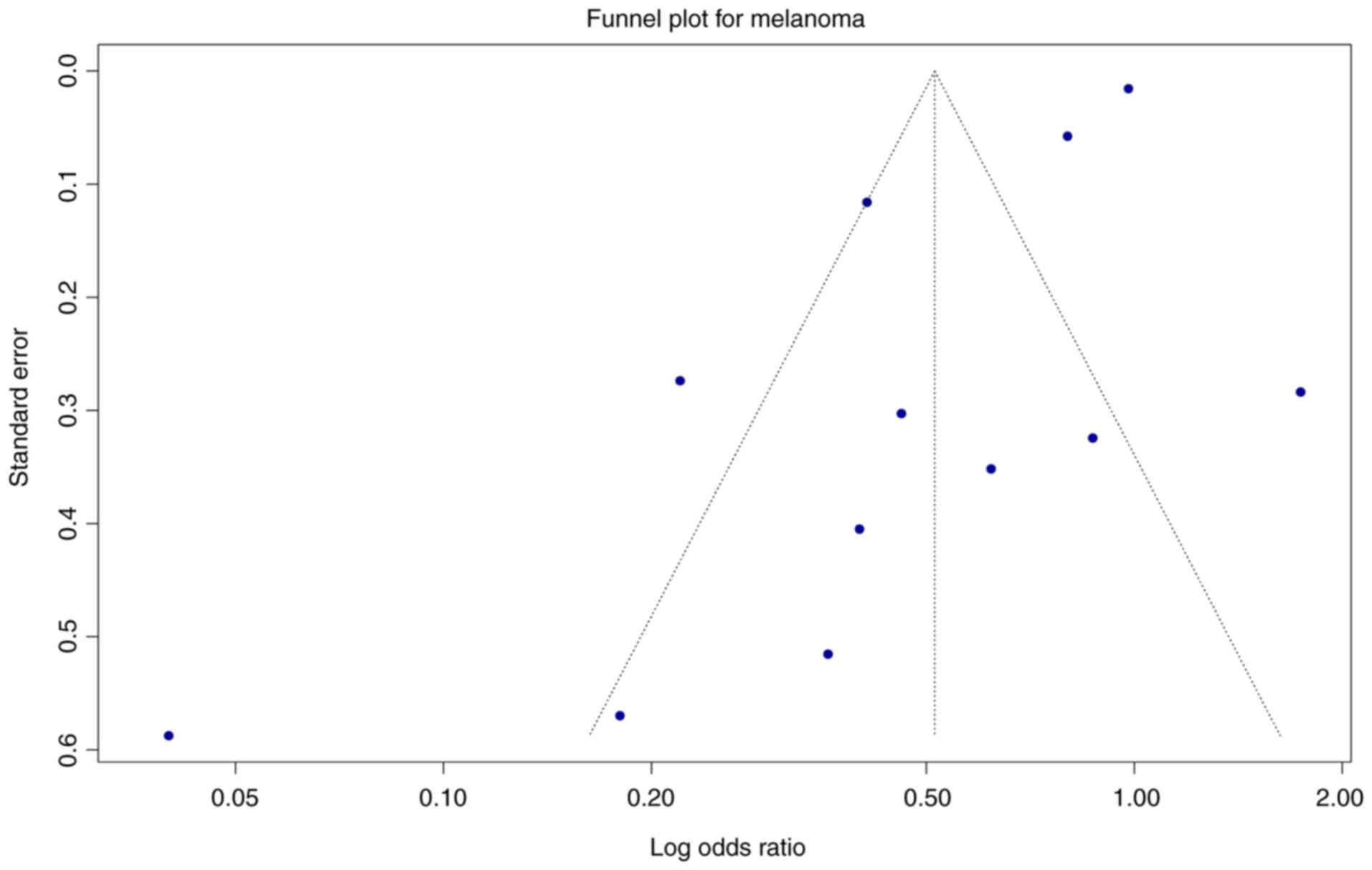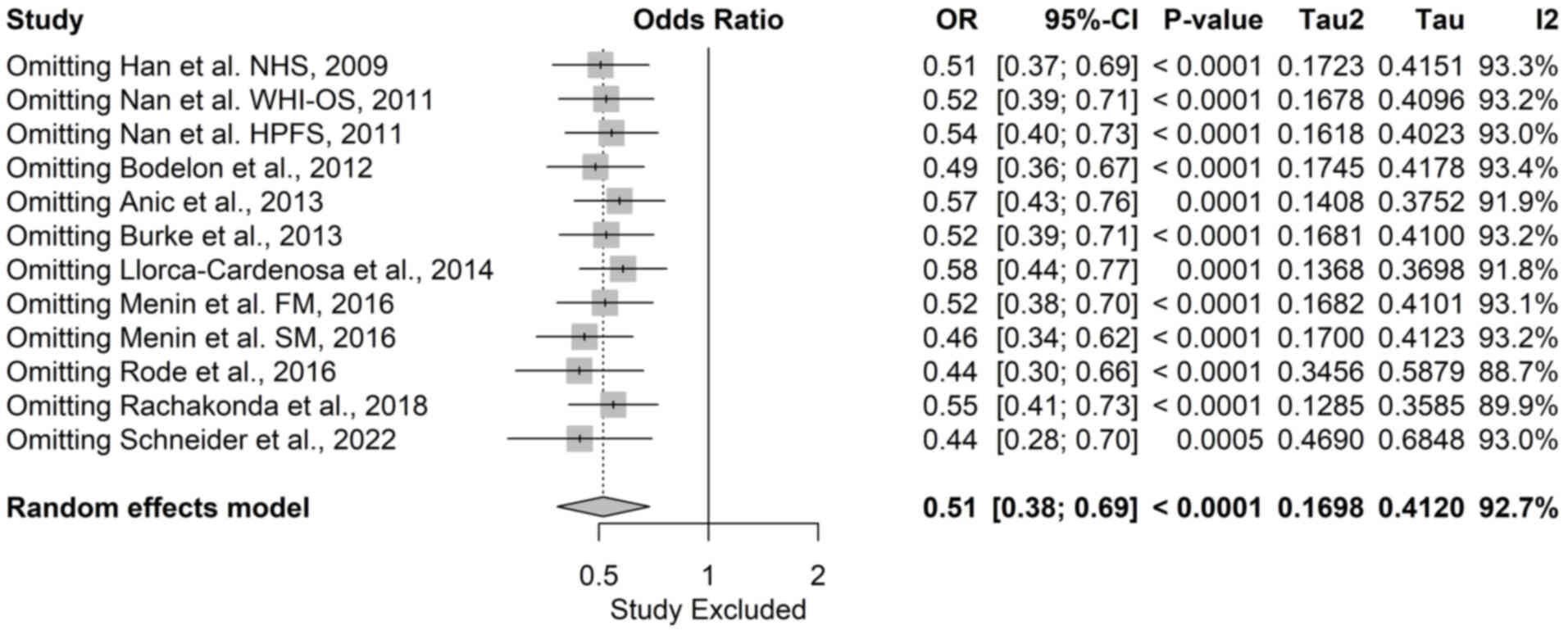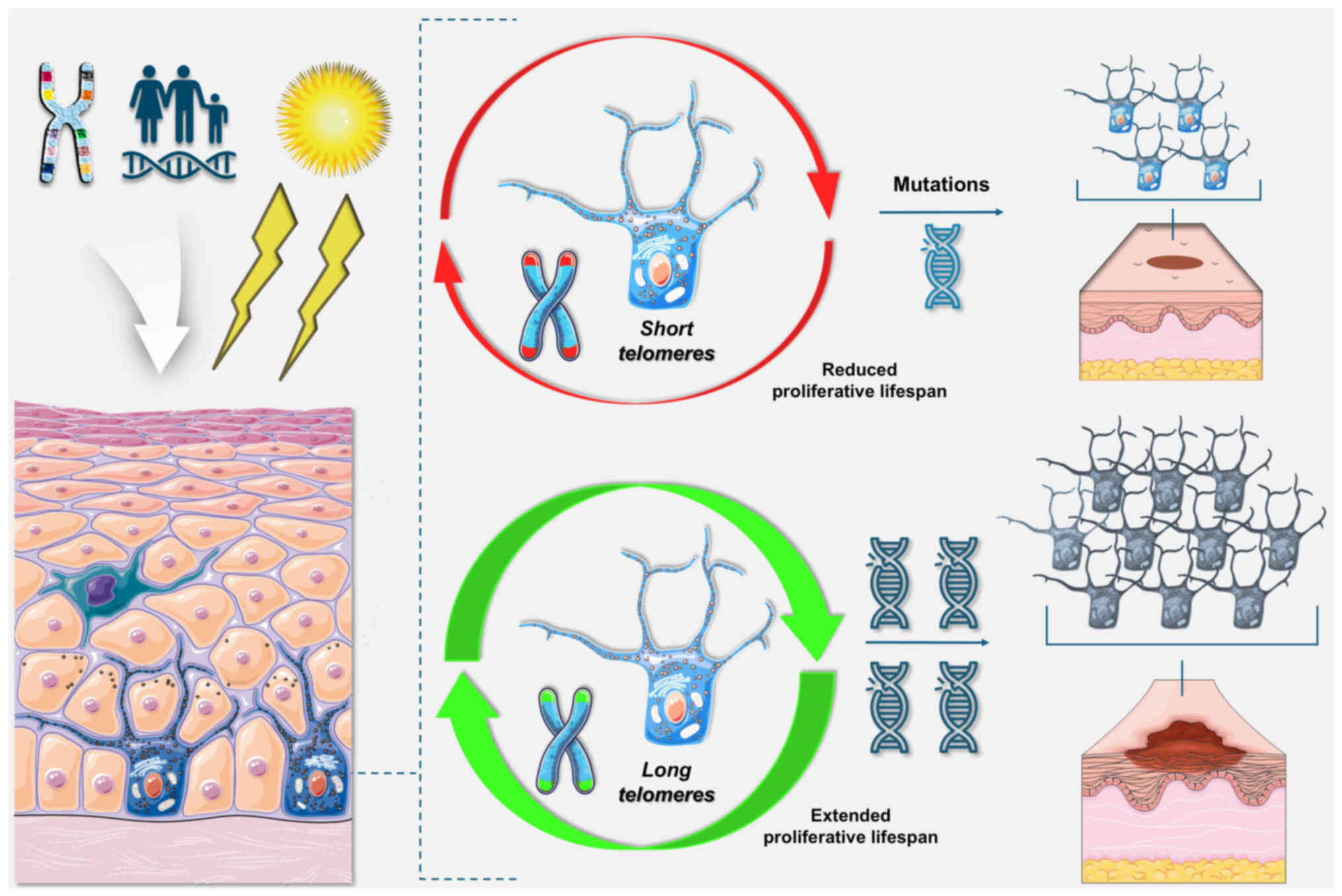|
1
|
Apalla Z, Nashan D, Weller RB and
Castellsagué X: Skin cancer: Epidemiology, disease burden,
pathophysiology, diagnosis, and therapeutic approaches. Dermatol
Ther (Heidelb). 7 (Suppl 1):S5–S19. 2017. View Article : Google Scholar : PubMed/NCBI
|
|
2
|
Lomas A, Leonardi-Bee J and Bath-Hextall
F: A systematic review of worldwide incidence of nonmelanoma skin
cancer. Br J Dermatol. 166:1069–1080. 2012. View Article : Google Scholar : PubMed/NCBI
|
|
3
|
Smith H, Wernham A and Patel A: When to
suspect a non-melanoma skin cancer. BMJ. 368:m6922020. View Article : Google Scholar : PubMed/NCBI
|
|
4
|
Grabowski J, Saltzstein SL, Sadler GR,
Tahir Z and Blair S: A Comparison of merkel cell carcinoma and
melanoma: Results from the California cancer registry. Clin Med
Oncol. 2:327–333. 2008.PubMed/NCBI
|
|
5
|
Yanofsky VR, Mercer SE and Phelps RG:
Histopathological variants of cutaneous squamous cell carcinoma: A
review. J Skin Cancer. 2011:2108132011. View Article : Google Scholar : PubMed/NCBI
|
|
6
|
Wong CSM: Basal cell carcinoma. BMJ.
327:794–798. 2003. View Article : Google Scholar : PubMed/NCBI
|
|
7
|
Peterson SC, Eberl M, Vagnozzi AN, Belkadi
A, Veniaminova NA, Verhaegen ME, Bichakjian CK, Ward NL, Dlugosz AA
and Wong SY: Basal cell carcinoma preferentially arises from stem
cells within hair follicle and mechanosensory niches. Cell Stem
Cell. 16:400–412. 2015. View Article : Google Scholar : PubMed/NCBI
|
|
8
|
Kim RH and Armstrong AW: Nonmelanoma skin
cancer. Dermatol Clin. 30:125–139. 2012. View Article : Google Scholar : PubMed/NCBI
|
|
9
|
Motley R, Kersey P and Lawrence C; British
Association of Dermatologists; British Association of Plastic
Surgeons; Royal College of Radiologists, Faculty of Clinical
Oncology, : Multiprofessional guidelines for the management of the
patient with primary cutaneous squamous cell carcinoma. Br J
Dermatol. 146:18–25. 2002. View Article : Google Scholar : PubMed/NCBI
|
|
10
|
Preston DS and Stern RS: Nonmelanoma
cancers of the Skin. N Engl J Med. 327:1649–1662. 1992. View Article : Google Scholar : PubMed/NCBI
|
|
11
|
Miller DL and Weinstock MA: Nonmelanoma
skin cancer in the United States: Incidence. J Am Acad Dermatol.
30:774–778. 1994. View Article : Google Scholar : PubMed/NCBI
|
|
12
|
Gloster HM and Brodland DG: The
epidemiology of skin cancer. Dermatol Surg. 22:217–326. 1996.
View Article : Google Scholar : PubMed/NCBI
|
|
13
|
Revenga Arranz F, Paricio Rubio J, Mar
Vázquez Salvado M and Del Villar Sordo V: Descriptive epidemiology
of basal cell carcinoma and cutaneous squamous cell carcinoma in
Soria (north-eastern Spain) 1998–2000: A hospital-based survey. J
Eur Acad Dermatol Venereol. 18:137–141. 2004. View Article : Google Scholar : PubMed/NCBI
|
|
14
|
De Vries E, Trakatelli M, Kalabalikis D,
Ferrandiz L, Ruiz-de-Casas A, Moreno-Ramirez D, Sotiriadis D,
Ioannides D, Aquilina S, Apap C, et al: Known and potential new
risk factors for skin cancer in European populations: A multicentre
case-control study: Risk factors for skin cancer in European
populations. Br J Dermatol. 167 (Suppl 2):S1–S13. 2012. View Article : Google Scholar
|
|
15
|
Fargnoli MC, Piccioni A, Neri L, Tambone
S, Pellegrini C and Peris K: Long-term efficacy and safety of
daylight photodynamic therapy with methyl amninolevulinate for
actinic keratosis of the face and scalp. Eur J Dermatol. 27:89–91.
2017. View Article : Google Scholar : PubMed/NCBI
|
|
16
|
Alam M and Ratner D: Cutaneous
Squamous-cell carcinoma. N Engl J Med. 344:975–983. 2001.
View Article : Google Scholar : PubMed/NCBI
|
|
17
|
Braeuer RR, Watson IR, Wu C, Mobley AK,
Kamiya T, Shoshan E and Bar-Eli M: Why is melanoma so metastatic?
Pigment Cell Melanoma Res. 27:19–36. 2014. View Article : Google Scholar : PubMed/NCBI
|
|
18
|
Cust AE, Armstrong BK, Goumas C, Jenkins
MA, Schmid H, Hopper JL, Kefford RF, Giles GG, Aitken JF and Mann
GJ: Sunbed use during adolescence and early adulthood is associated
with increased risk of early-onset melanoma. Int J Cancer.
128:2425–2435. 2011. View Article : Google Scholar : PubMed/NCBI
|
|
19
|
Arnold M, De Vries E, Whiteman DC, Jemal
A, Bray F, Parkin DM and Soerjomataram I: Global burden of
cutaneous melanoma attributable to ultraviolet radiation in 2012.
Int J Cancer. 143:1305–1314. 2018. View Article : Google Scholar : PubMed/NCBI
|
|
20
|
Elder DE, Bastian BC, Cree IA, Massi D and
Scolyer RA: The 2018 World Health Organization classification of
cutaneous, mucosal, and uveal melanoma: Detailed analysis of 9
distinct subtypes defined by their evolutionary pathway. Arch
Pathol Lab Med. 144:500–522. 2020. View Article : Google Scholar : PubMed/NCBI
|
|
21
|
Gandini S, Sera F, Cattaruzza MS, Pasquini
P, Picconi O, Boyle P and Melchi CF: Meta-analysis of risk factors
for cutaneous melanoma: II. Sun exposure. Eur J Cancer. 41:45–60.
2005. View Article : Google Scholar : PubMed/NCBI
|
|
22
|
Rastrelli M, Tropea S, Rossi CR and
Alaibac M: Melanoma: Epidemiology, risk factors, pathogenesis,
diagnosis and classification. In Vivo. 28:1005–1011.
2014.PubMed/NCBI
|
|
23
|
Ferlay J, Soerjomataram I, Dikshit R, Eser
S, Mathers C, Rebelo M, Parkin DM, Forman D and Bray F: Cancer
incidence and mortality worldwide: Sources, methods and major
patterns in GLOBOCAN 2012. Int J Cancer. 136:E359–E86. 2015.
View Article : Google Scholar : PubMed/NCBI
|
|
24
|
Chang C, Murzaku EC, Penn L, Abbasi NR,
Davis PD, Berwick M and Polsky D: More skin, more sun, more tan,
more melanoma. Am J Public Health. 104:e92–e99. 2014. View Article : Google Scholar : PubMed/NCBI
|
|
25
|
Leonardi GC, Falzone L, Salemi R, Zanghï
A, Spandidos DA, Mccubrey JA, Candido S and Libra M: Cutaneous
melanoma: From pathogenesis to therapy (Review). Int J Oncol.
52:1071–1080. 2018.PubMed/NCBI
|
|
26
|
Blackburn EH, Epel ES and Lin J: Human
telomere biology: A contributory and interactive factor in aging,
disease risks, and protection. Science. 350:1193–1198. 2015.
View Article : Google Scholar : PubMed/NCBI
|
|
27
|
Moon IK and Jarstfer MB: The human
telomere and its relationship to human disease, therapy, and tissue
engineering. Front Biosci J Virtual Libr. 12:4595–4620. 2007.
View Article : Google Scholar : PubMed/NCBI
|
|
28
|
O'Sullivan RJ and Karlseder J: Telomeres:
Protecting chromosomes against genome instability. Nat Rev Mol Cell
Biol. 11:171–1781. 2010. View Article : Google Scholar : PubMed/NCBI
|
|
29
|
De Lange T: How telomeres solve the
End-protection problem. Science. 326:948–952. 2009. View Article : Google Scholar : PubMed/NCBI
|
|
30
|
Monaghan P and Haussmann MF: Do telomere
dynamics link lifestyle and lifespan? Trends Ecol Evol. 21:47–53.
2006. View Article : Google Scholar : PubMed/NCBI
|
|
31
|
Shay JW and Wright WE: Hayflick, his
limit, and cellular ageing. Nat Rev Mol Cell Biol. 1:72–76. 2000.
View Article : Google Scholar : PubMed/NCBI
|
|
32
|
Shay JW and Wright WE: Role of telomeres
and telomerase in cancer. Semin Cancer Biol. 21:349–353. 2011.
View Article : Google Scholar : PubMed/NCBI
|
|
33
|
Artandi SE and DePinho RA: Telomeres and
telomerase in cancer. Carcinogenesis. 31:9–18. 2010. View Article : Google Scholar : PubMed/NCBI
|
|
34
|
Shay JW and Bacchetti S: A survey of
telomerase activity in human cancer. Eur J Cancer. 33:787–791.
1997. View Article : Google Scholar : PubMed/NCBI
|
|
35
|
Maciejowski J and de Lange T: Telomeres in
cancer: Tumour suppression and genome instability. Nat Rev Mol Cell
Biol. 18:175–186. 2017. View Article : Google Scholar : PubMed/NCBI
|
|
36
|
Robinson NJ and Schiemann WP: Telomerase
in cancer: Function, regulation, and clinical translation. Cancers.
14:8082022. View Article : Google Scholar : PubMed/NCBI
|
|
37
|
Xu Y and Goldkorn A: Telomere and
telomerase therapeutics in cancer. Genes. 7:222016. View Article : Google Scholar : PubMed/NCBI
|
|
38
|
Dratwa M, Wysoczańska B, Łacina P, Kubik T
and Bogunia-Kubik K: TERT-Regulation and roles in cancer formation.
Front Immunol. 11:5899292020. View Article : Google Scholar : PubMed/NCBI
|
|
39
|
Tsatsakis A, Oikonomopoulou T,
Nikolouzakis TK, Vakonaki E, Tzatzarakis M, Flamourakis M, Renieri
E, Fragkiadaki P, Iliaki E, Bachlitzanaki M, et al: Role of
telomere length in human carcinogenesis (Review). Int J Oncol.
63:782023. View Article : Google Scholar : PubMed/NCBI
|
|
40
|
López-Otín C, Pietrocola F, Roiz-Valle D,
Galluzzi L and Kroemer G: Meta-hallmarks of aging and cancer. Cell
Metab. 35:12–35. 2023. View Article : Google Scholar : PubMed/NCBI
|
|
41
|
Hanahan D and Weinberg RA: Hallmarks of
cancer: The next generation. Cell. 144:646–674. 2011. View Article : Google Scholar : PubMed/NCBI
|
|
42
|
Okamoto K and Seimiya H: Revisiting
telomere shortening in cancer. Cells. 8:1072019. View Article : Google Scholar : PubMed/NCBI
|
|
43
|
Andreikos D, Kyrodimos E, Kotsinas A,
Chrysovergis A and Papacharalampous GX: The Association between
telomere length and head and neck cancer risk: A systematic review
and Meta-analysis. Int J Mol Sci. 25:90002024. View Article : Google Scholar : PubMed/NCBI
|
|
44
|
Karimi B, Yunesian M, Nabizadeh R,
Mehdipour P and Aghaie A: Is leukocyte telomere length related with
lung cancer risk?: A Meta-Analysis. Iran Biomed J. 21:142–153.
2017. View Article : Google Scholar : PubMed/NCBI
|
|
45
|
Ma H, Zhou Z, Wei S, Liu Z, Pooley KA,
Dunning AM, Svenson U, Roos G, Hosgood HD III, Shen M and Wei Q:
Shortened telomere length is associated with increased risk of
cancer: A meta-analysis. PLoS One. 6:e204662011. View Article : Google Scholar : PubMed/NCBI
|
|
46
|
Zhu X, Han W, Xue W, Zou Y, Xie C, Du J
and Jin G: The association between telomere length and cancer risk
in population studies. Sci Rep. 6:222432016. View Article : Google Scholar : PubMed/NCBI
|
|
47
|
Benites-Zapata VA, Ulloque-Badaracco JR,
Alarcón-Braga EA, Fernández-Alonso AM, López-Baena MT and
Pérez-López FR: Telomerase activity and telomere length in women
with breast cancer or without malignancy: A systematic review and
meta-analysis. Maturitas. 180:1078822024. View Article : Google Scholar : PubMed/NCBI
|
|
48
|
Naing C, Aung K, Lai PK and Mak JW:
Association between telomere length and the risk of colorectal
cancer: A meta-analysis of observational studies. BMC Cancer.
17:242017. View Article : Google Scholar : PubMed/NCBI
|
|
49
|
Caini S, Raimondi S, Johansson H, De
Giorgi V, Zanna I, Palli D and Gandini S: Telomere length and the
risk of cutaneous melanoma and non-melanoma skin cancer: A review
of the literature and meta-analysis. J Dermatol Sci. 80:168–174.
2015. View Article : Google Scholar : PubMed/NCBI
|
|
50
|
Rode L, Nordestgaard BG and Bojesen SE:
Long telomeres and cancer risk among 95 568 individuals from the
general population. Int J Epidemiol. 45:1634–1643. 2016. View Article : Google Scholar : PubMed/NCBI
|
|
51
|
Fabiani R, Chiavarini M, Rosignoli P and
Giacchetta I: Leucocyte telomere length and lung cancer risk: A
systematic review and Meta-analysis of prospective studies. Cancers
(Basel). 16:32182024. View Article : Google Scholar : PubMed/NCBI
|
|
52
|
Chen S, Hu S, Zhou B, Cheng B, Tong H, Su
D, Li X, Chen Y and Zhang G: Telomere-related prognostic biomarkers
for survival assessments in pancreatic cancer. Sci Rep.
13:105862023. View Article : Google Scholar : PubMed/NCBI
|
|
53
|
Holesova Z, Krasnicanova L, Saade R, Pös
O, Budis J, Gazdarica J, Repiska V and Szemes T: Telomere length
changes in cancer: Insights on carcinogenesis and potential for
Non-invasive diagnostic strategies. Genes (Basel). 14:7152023.
View Article : Google Scholar : PubMed/NCBI
|
|
54
|
Wentzensen IM, Mirabello L, Pfeiffer RM
and Savage SA: The association of telomere length and cancer: A
meta-analysis. Cancer Epidemiol Biomarkers Prev. 20:1238–1250.
2011. View Article : Google Scholar : PubMed/NCBI
|
|
55
|
Page MJ, McKenzie JE, Bossuyt PM, Boutron
I, Hoffmann TC, Mulrow CD, Shamseer L, Tetzlaff JM, Akl EA, Brennan
SE, et al: The PRISMA 2020 statement: An updated guideline for
reporting systematic reviews. BMJ. 372:n712021. View Article : Google Scholar : PubMed/NCBI
|
|
56
|
Higgins JPT: Measuring inconsistency in
meta-analyses. BMJ. 327:557–560. 2003. View Article : Google Scholar : PubMed/NCBI
|
|
57
|
Green S and Higgins JPT: Cochrane Handbook
for Systematic Reviews of Interventions. The Cochrane
Collaboration. http://training.cochrane.org/handbookMarch
20–2025
|
|
58
|
DerSimonian R and Laird N: Meta-analysis
in clinical trials. Control Clin Trials. 7:177–188. 1986.
View Article : Google Scholar : PubMed/NCBI
|
|
59
|
Egger M, Smith GD, Schneider M and Minder
C: Bias in meta-analysis detected by a simple, graphical test. BMJ.
315:629–634. 1997. View Article : Google Scholar : PubMed/NCBI
|
|
60
|
Sterne JAC, Gavaghan D and Egger M:
Publication and related bias in meta-analysis. J Clin Epidemiol.
53:1119–1129. 2000. View Article : Google Scholar : PubMed/NCBI
|
|
61
|
Wells GA, Shea B, O'Connell D, Peterson J,
Welch V, Losos M and Tugwell P: The Newcastle-Ottawa Scale (NOS)
for Assessing the Quality of Nonrandomised Studies in
Meta-Analyses. 2013. http://www.ohri.ca/programs/clinical_epidemiology/oxford.aspMarch
20–2025
|
|
62
|
Han J, Qureshi AA, Prescott J, Guo Q, Ye
L, Hunter DJ and De Vivo I: A Prospective study of telomere length
and the risk of skin cancer. J Invest Dermatol. 129:415–421. 2009.
View Article : Google Scholar : PubMed/NCBI
|
|
63
|
Nan H, Du M, De Vivo I, Manson JE, Liu S,
McTiernan A, Curb JD, Lessin LS, Bonner MR, Guo Q, et al: Shorter
telomeres associate with a reduced risk of melanoma development.
Cancer Res. 71:6758–6763. 2011. View Article : Google Scholar : PubMed/NCBI
|
|
64
|
Weischer M: Short telomere length, cancer
survival, and cancer risk in 47102 individuals. J Natl Cancer Inst.
105:459–468. 2013. View Article : Google Scholar : PubMed/NCBI
|
|
65
|
Greenland S, Thomas DC and Morgenstern H:
The rare-disease assumption revisited. Am J Epidemiol. 124:869–876.
1986. View Article : Google Scholar : PubMed/NCBI
|
|
66
|
Anic GM, Sondak VK, Messina JL, Fenske NA,
Zager JS, Cherpelis BS, Lee JH, Fulp WJ, Epling-Burnette PK, Park
JY and Rollison DE: Telomere length and risk of melanoma, squamous
cell carcinoma, and basal cell carcinoma. Cancer Epidemiol.
37:434–439. 2013. View Article : Google Scholar : PubMed/NCBI
|
|
67
|
Rachakonda S, Kong H, Srinivas N,
Garcia-Casado Z, Requena C, Fallah M, Heidenreich B, Planelles D,
Traves V, Schadendorf D, et al: Telomere length, telomerase reverse
transcriptase promoter mutations, and melanoma risk. Genes
Chromosomes Cancer. 57:564–572. 2018. View Article : Google Scholar : PubMed/NCBI
|
|
68
|
Schneider CV, Schneider KM, Teumer A,
Rudolph KL, Hartmann D, Rader DJ and Strnad P: Association of
telomere length with risk of disease and mortality. JAMA Intern
Med. 182:291–300. 2022. View Article : Google Scholar : PubMed/NCBI
|
|
69
|
Bodelon C, Pfeiffer RM, Bollati V,
Debbache J, Calista D, Ghiorzo P, Fargnoli MC, Bianchi-Scarra G,
Peris K, Hoxha M, et al: On the interplay of telomeres, nevi and
the risk of melanoma. PLoS One. 7:e524662012. View Article : Google Scholar : PubMed/NCBI
|
|
70
|
Llorca-Cardeñosa MJ, Peña-Chilet M, Mayor
M, Gomez-Fernandez C, Casado B, Martin-Gonzalez M, Carretero G,
Lluch A, Martinez-Cadenas C, Ibarrola-Villava M and Ribas G: Long
telomere length and a TERT-CLPTM1 locus polymorphism association
with melanoma risk. Eur J Cancer. 50:3168–3177. 2014. View Article : Google Scholar : PubMed/NCBI
|
|
71
|
Menin C, Bojnik E, Del Bianco P, Elefanti
L, Gianesin K, Keppel S, Stagni C, Mocellin S, Vecchiato A and De
Rossi A: Differences in telomere length between sporadic and
familial cutaneous melanoma. Br J Dermatol. 175:937–943. 2016.
View Article : Google Scholar : PubMed/NCBI
|
|
72
|
Burke LS, Hyland PL, Pfeiffer RM, Prescott
J, Wheeler W, Mirabello L, Savage SA, Burdette L, Yeager M, Chanock
S, et al: Telomere length and the risk of cutaneous malignant
melanoma in Melanoma-Prone families with and without CDKN2A
mutations. PLoS One. 8:e711212013. View Article : Google Scholar : PubMed/NCBI
|
|
73
|
Perrem K, Lynch A, Al Nooh F, Leader M and
Elaine Kay: The different telomere lengths in basal and squamous
cell carcinomas also differ between the nontransplant and renal
transplant population. Hum Pathol. 39:1034–1041. 2008. View Article : Google Scholar : PubMed/NCBI
|
|
74
|
Srinivas N, Rachakonda S, Hielscher T,
Calderazzo S, Rudnai P, Gurzau E, Koppova K, Fletcher T and Kumar
R: Telomere length, arsenic exposure and risk of basal cell
carcinoma of skin. Carcinogenesis. 40:715–723. 2019. View Article : Google Scholar : PubMed/NCBI
|
|
75
|
Liang G, Qureshi AA, Guo Q, De Vivo I and
Han J: No association between telomere length in peripheral blood
leukocytes and the risk of nonmelanoma skin cancer. Cancer
Epidemiol Biomarkers Prev. 20:1043–1045. 2011. View Article : Google Scholar : PubMed/NCBI
|
|
76
|
Wainwright LJ, Rees JL and Middleton PG:
Changes in mean telomere length in basal cell carcinomas of the
skin. Genes Chromosomes Cancer. 12:45–49. 1995. View Article : Google Scholar : PubMed/NCBI
|
|
77
|
Perrem K, Lynch A, Conneely M, Wahlberg H,
Murphy G, Leader M and Kay E: The higher incidence of squamous cell
carcinoma in renal transplant recipients is associated with
increased telomere lengths. Hum Pathol. 38:351–358. 2007.
View Article : Google Scholar : PubMed/NCBI
|
|
78
|
De Vitis M, Berardinelli F and Sgura A:
Telomere length maintenance in cancer: At the crossroad between
telomerase and alternative lengthening of telomeres (ALT). Int J
Mol Sci. 19:6062018. View Article : Google Scholar : PubMed/NCBI
|
|
79
|
Andreikos D, Spandidos D and
Georgakopoulou V: Telomeres and telomerase in mesothelioma:
Pathophysiology, biomarkers and emerging therapeutic strategies
(Review). Int J Oncol. 66:232025. View Article : Google Scholar : PubMed/NCBI
|
|
80
|
Mooi WJ and Peeper DS: Oncogene-induced
cell Senescence-halting on the road to cancer. N Engl J Med.
355:1037–1046. 2006. View Article : Google Scholar : PubMed/NCBI
|
|
81
|
Gray-Schopfer VC, Cheong SC, Chong H, Chow
J, Moss T, Abdel-Malek ZA, Marais R, Wynford-Thomas D and Bennett
DC: Cellular senescence in naevi and immortalisation in melanoma: A
role for p16? Br J Cancer. 95:496–505. 2006. View Article : Google Scholar : PubMed/NCBI
|
|
82
|
Bataille V, Kato BS, Falchi M, Gardner J,
Kimura M, Lens M, Perks U, Valdes AM, Bennett DC, Aviv A and
Spector TD: Nevus size and number are associated with telomere
length and represent potential markers of a decreased senescence in
vivo. Cancer Epidemiol Biomarkers Prev. 16:1499–1502. 2007.
View Article : Google Scholar : PubMed/NCBI
|
|
83
|
Robles-Espinoza CD, Velasco-Herrera M del
C, Hayward NK and Adams DJ: Telomere-regulating genes and the
telomere interactome in familial cancers. Mol Cancer Res.
13:211–222. 2015. View Article : Google Scholar : PubMed/NCBI
|
|
84
|
Toussi A, Mans N, Welborn J and Kiuru M:
Germline mutations predisposing to melanoma. J Cutan Pathol.
47:606–616. 2020. View Article : Google Scholar : PubMed/NCBI
|
|
85
|
Son N, Cui Y and Xi W: Association between
telomere length and skin cancer and aging: A mendelian
randomization analysis. Front Genet. 13:9317852022. View Article : Google Scholar : PubMed/NCBI
|
|
86
|
McNally EJ, Luncsford PJ and Armanios M:
Long telomeres and cancer risk: The price of cellular immortality.
J Clin Invest. 129:3474–3481. 2019. View Article : Google Scholar : PubMed/NCBI
|
|
87
|
Stanley SE and Armanios M: The short and
long telomere syndromes: Paired paradigms for molecular medicine.
Curr Opin Genet Dev. 33:1–9. 2015. View Article : Google Scholar : PubMed/NCBI
|
|
88
|
Barrett ELB, Burke TA, Hammers M, Komdeur
J and Richardson DS: Telomere length and dynamics predict mortality
in a wild longitudinal study. Mol Ecol. 22:249–259. 2013.
View Article : Google Scholar : PubMed/NCBI
|
|
89
|
Speedy HE, Di Bernardo MC, Sava GP, Dyer
MJS, Holroyd A, Wang Y, Sunter NJ, Mansouri L, Juliusson G, Smedby
KE, et al: A genome-wide association study identifies multiple
susceptibility loci for chronic lymphocytic leukemia. Nat Genet.
46:56–60. 2014. View Article : Google Scholar : PubMed/NCBI
|
|
90
|
Rachakonda S, Srinivas N, Mahmoudpour SH,
Garcia-Casado Z, Requena C, Traves V, Soriano V, Cardelli M,
Pjanova D, Molven A, et al: Telomere length and survival in primary
cutaneous melanoma patients. Sci Rep. 8:109472018. View Article : Google Scholar : PubMed/NCBI
|
|
91
|
Martinez-Delgado B, Yanowsky K,
Inglada-Perez L, De La Hoya M, Caldes T, Vega A, Blanco A, Martin
T, Gonzalez-Sarmiento R, Blasco M, et al: Shorter telomere length
is associated with increased ovarian cancer risk in both familial
and sporadic cases. J Med Genet. 49:341–344. 2012. View Article : Google Scholar : PubMed/NCBI
|
|
92
|
Martinez-Delgado B, Yanowsky K,
Inglada-Perez L, Domingo S, Urioste M, Osorio A and Benitez J:
Genetic anticipation is associated with telomere shortening in
hereditary breast cancer. PLoS Genet. 7:e10021822011. View Article : Google Scholar : PubMed/NCBI
|
|
93
|
Rossi M, Pellegrini C, Cardelli L,
Ciciarelli V, Di Nardo L and Fargnoli MC: Familial melanoma:
Diagnostic and management implications. Dermatol Pract Concept.
9:10–16. 2019. View Article : Google Scholar : PubMed/NCBI
|
|
94
|
Zocchi L, Lontano A, Merli M, Dika E,
Nagore E, Quaglino P, Puig S and Ribero S: Familial Melanoma and
susceptibility genes: A review of the most common clinical and
dermoscopic phenotypic aspect, associated malignancies and
practical tips for management. J Clin Med. 10:37602021. View Article : Google Scholar : PubMed/NCBI
|
|
95
|
Hansen MEB, Hunt SC, Stone RC, Horvath K,
Herbig U, Ranciaro A, Hirbo J, Beggs W, Reiner AP, Wilson JG, et
al: Shorter telomere length in Europeans than in Africans due to
polygenetic adaptation. Hum Mol Genet. 25:2324–2330. 2016.
View Article : Google Scholar : PubMed/NCBI
|
|
96
|
Chang YM, Barrett JH, Bishop DT, Armstrong
BK, Bataille V, Bergman W, Berwick M, Bracci PM, Elwood JM,
Ernstoff MS, et al: Sun exposure and melanoma risk at different
latitudes: A pooled analysis of 5700 cases and 7216 controls. Int J
Epidemiol. 38:814–830. 2009. View Article : Google Scholar : PubMed/NCBI
|
|
97
|
Armstrong BK and Kricker A: The
epidemiology of UV induced skin cancer. J Photochem Photobiol B.
63:8–18. 2001. View Article : Google Scholar : PubMed/NCBI
|
|
98
|
Lundsgaard NU, Cramp RL and Franklin CE:
Early exposure to UV radiation causes telomere shortening and
poorer condition later in life. J Exp Biol. 225:jeb2439242022.
View Article : Google Scholar : PubMed/NCBI
|
|
99
|
Gardner M, Bann D, Wiley L, Cooper R,
Hardy R, Nitsch D, Martin-Ruiz C, Shiels P, Sayer AA, Barbieri M,
et al: Gender and telomere length: Systematic review and
meta-analysis. Exp Gerontol. 51:15–27. 2014. View Article : Google Scholar : PubMed/NCBI
|
|
100
|
Kyo S, Takakura M, Kanaya T, Zhuo W,
Fujimoto K, Nishio Y, Orimo A and Inoue M: Estrogen activates
telomerase. Cancer Res. 59:5917–5921. 1999.PubMed/NCBI
|
|
101
|
Ventura A, Pellegrini C, Cardelli L, Rocco
T, Ciciarelli V, Peris K and Fargnoli MC: Telomeres and telomerase
in cutaneous squamous cell carcinoma. Int J Mol Sci. 20:13332019.
View Article : Google Scholar : PubMed/NCBI
|
|
102
|
Gilchrest BA, Eller MS, Geller AC and Yaar
M: The pathogenesis of melanoma induced by ultraviolet radiation. N
Engl J Med. 340:1341–1348. 1999. View Article : Google Scholar : PubMed/NCBI
|
|
103
|
Yamada-Hishida H, Nobeyama Y and Nakagawa
H: Correlation of telomere length to malignancy potential in
non-melanoma skin cancers. Oncol Lett. 15:393–399. 2018.PubMed/NCBI
|
|
104
|
Grimes DA and Schulz KF: Bias and causal
associations in observational research. Lancet. 359:248–252. 2002.
View Article : Google Scholar : PubMed/NCBI
|
|
105
|
Glasziou PP and Sanders SL: Investigating
causes of heterogeneity in systematic reviews. Stat Med.
21:1503–1511. 2002. View Article : Google Scholar : PubMed/NCBI
|
|
106
|
Montpetit AJ, Alhareeri AA, Montpetit M,
Starkweather AR, Elmore LW, Filler K, Mohanraj L, Burton CW,
Menzies VS, Lyon DE and Jackson-Cook CK: Telomere length: A review
of methods for measurement. Nurs Res. 63:289–299. 2014. View Article : Google Scholar : PubMed/NCBI
|
|
107
|
Gutierrez-Rodrigues F, Santana-Lemos BA,
Scheucher PS, Alves-Paiva RM and Calado RT: Direct comparison of
Flow-FISH and qPCR as diagnostic tests for telomere length
measurement in humans. PLoS One. 9:e1137472014. View Article : Google Scholar : PubMed/NCBI
|
|
108
|
Lin L: Bias caused by sampling error in
meta-analysis with small sample sizes. PLoS One. 13:e02040562018.
View Article : Google Scholar : PubMed/NCBI
|















